This is an Argus A2F, a 35mm scale focus camera made by the Argus Corporation of Ann Arbor, MI. It was part of the Argus A-series which were the very first American made cameras to use the new 135 format 35mm film. The A2F was the top of the line pre-war model featuring both an extinction meter to help with calculating exposure, and a collapsible lens with a helical focus that had a range from 15″ to infinity. It had a Bakelite body with an aluminum back that featured a prominent art-deco pattern. There were half a dozen different A-series models prior to WWII, but only 2 were produced after the war as entry level models.
Film Type: 135 (35mm)
Lens: Unknown focal length (probably 50mm) f/4.5 Anastigmat uncoated 3 elements
Focus: 15″ to Infinity (yes that’s right, 15 inches!)
Viewfinder: Scale Focus
Shutter: Ilex Precise Leaf
Speeds: T, B, 1/25 – 1/200 seconds
Exposure Meter: Extinction Meter
Battery: None
Flash Mount: None
Weight: 414 grams
Manual: http://media.aadl.org/documents/pdf/argus_camera/argus_instruction_manual-argus_model_a2f.pdf
How these ratings work |
The Argus A could very well be the “perfect” vintage camera. It is cheap, well made, reliable, makes good photos, is easy to use, and is very old. It doesn’t do anything spectacularly better than other cameras, but that’s not the point. It’s also compact and light weight (especially compared to the C3). There’s so many of these available for dirty cheap prices, and even if they are dirty, they’re easy to bring back to life. For this reason, there’s no reason that any camera collector shouldn’t have one (or many) of these in their collection. The A2F is the most feature rich A-series, but any of them will do. | ||||||
| Images | Handling | Features | Viewfinder | Feel & Beauty | History | Age | |
| 2 | 0 | 1 | 0 | 1 | 1 | 40% | |
| Bonus | +1 for its unique features like extinction meter, 360 plunger shutter, and 15 inch minimum focus helical system. | ||||||
| Final Score | 8.0 | ||||||
History
Based in Ann Arbor, MI, Argus was founded in 1931 as the International Radio Corporation. Back then, IRC made a variety of different radios, some of which had pioneering designs. IRC’s products included the Kadette which was the first mass produced AC/DC radio. Although it looked to be made of wood, it was actually made from Bakelite plastic which made it inexpensive and portable. It sold extremely well and allowed IRC to release other Kadette products like the Kadette Jr, which was the world’s first pocket radio, and the Kadette Clockette which was one of the first clock radios.
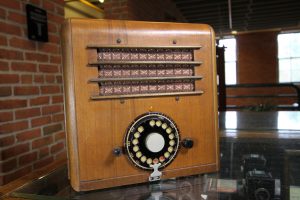
In the first half of the 1930s, IRC’s radio business was so successful in that it was the only company in Ann Arbor that was able to pay dividends to its share holders during the Great Depression. Nearby Detroit was heavily hit by the recession, so in the entire state of Michigan, IRC was one of the few financial bright spots.
By the mid 30s as the depression dragged on and other competing radio manufacturers were able to make inexpensive radios that ate into IRC’s profits, the company saw the need to diversify it’s product offerings.
Utilizing the company’s success with Bakelite and electronics, the company released the Argus Model A camera in 1936 to immediate success. Like it’s radio division, the Argus Model A was an inexpensive Bakelite body camera that brought cameras into a price range that didn’t have a lot of competition. The price of the Argus A was $10 (some sites say $12.50) which meant it could be afforded by the average lower to middle class family.
The Model A was the very first American made camera to use Kodak’s new 135 format 35mm film cassette. Even though Kodak had already been selling the Kodak Retina for 2 years prior to the Model A’s introduction, the Retina was a German designed and built camera made by Kodak AG, Kodak’s German subsidiary.
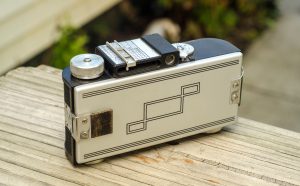
The Model A was very popular and quickly spawned several variants. Although the design of all A-series variants were very similar, the specs were slightly different between them all. None of the Argus A-series cameras had the model number visible on the outside of the camera, however the model number was a prefix or suffix of the serial number inside the film compartment on all models except the Model A.
All Argus cameras were scale focus only with a curved Bakelite body and a tin stamped back plate with an art-deco pattern. There were a very small amount of brown and gray Argus As, but they are very rare, and I do not believe any other models came in anything but black.
The differences between the rest of the A-series are:
- Model A (1936 – 1941) – Original model with f/4.5 collapsible lens.
- Model AF (1937 – 1938) – Same as Model A except with helical focus capable of a much wider focus range.
- Model B (1937) – Although called the Model B, its still considered to be part of the A-series because it was in every way identical to the Model A except that it came with a Prontor II shutter and f/2.9 lens.
- Model A2B (1939 – 1950) – One of only two A-series to be produced after WWII, it was the same as the Model A except with an extinction meter on top to assist in exposure calculation. The post-war models often had coated lens elements, a redesigned shutter release, and a black extinction meter chart (instead of silver) on top.
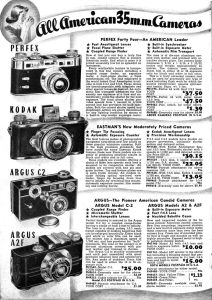
The Argus A2F is seen here in a 1939 catalog for Lafayette Camera Corp for $15. - Model A2F (1939 – 1941) – A combination of the AF and A2B it had both the helical focus and extinction meter on top. This model was the top of the line pre-war Argus A-series. Sold for $15 which compares to $275 today.
- Model AA (1940-1942) – A fixed focus model with an f/6.3 lens and flash sync ports on the side.
- Model FA (1950 – 1951) – The second post-war model, the FA replaced the A2B, losing the extinction meter, but added a flash sync port on the side (a different design than the AA).
There were also Argus Models A3 and A4, but they have a completely different design and are not considered to be part of the A-series.
Prior to World War II, the A-series was the only major 35mm camera built in the United States at a price point no higher than $15 (the exception being the Argus B which was $25, but it was only made in 1937 and sold poorly).
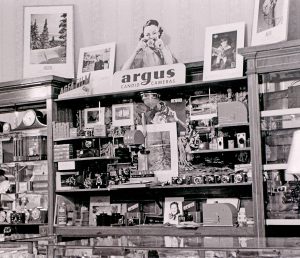
In 1938, Argus would release the Argus Model C which was a completely different camera with an integrated uncoupled rangefinder, an interchangeable lens mount, a top panel shutter release, and a faster 1/300 second shutter speed. Models C2 and C3 would quickly follow adding a coupled rangefinder and then flash synchronization, but these were marketed as higher end cameras.
After the war, the Argus Model A2B would be the lone A-series camera to resume production (the FA would replace the A2B for a very short time in 1950). It was marketed as an entry level alternative to the higher spec Argus C3. Most of the pre-war variants of the A-series were no longer made so as not to dilute sales of the more expensive C3. Both the A2B and C3 would remain in simultaneous production until 1950 at which time the C3 became Argus’ only 35mm camera.
Exact production numbers of the entire A-series are unknown, but the serial numbers of each Argus camera appeared to be sequential from year to year, so going off known serial number ranges on The Argus Camera Information Reference Site, it can be extrapolated that roughly half a million Argus A-series were made.
Today, the Argus A-series are a popular option for collectors looking for an example of early 1930s camera design. Although not as feature rich as the C-series, many people prefer the curved lines and light weight of the A-series over the brick-like shape of the C-series. Aiding their popularity is that they are often plentiful on auction sites and can be purchased for very cheap.
The cameras were well built and pretty reliable. Many Argus A-series cameras still work fine today, almost 80 years after they were made. If you acquire an A-series that is not in working order, often all it needs is a good cleaning of the shutter and lens.
My Thoughts / Repairs
The Argus C3 was one of my very first vintage cameras and although I liked that camera, I never really had any interest in checking out the A-series. It wasn’t until I spotted a really nice A2F in its original box with the manual at a vintage camera sale that I considered buying one.
Although I have several scale focus / viewfinder cameras in my collection, there were several things about this model that intrigued me:
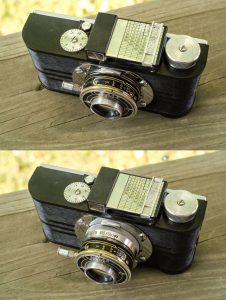
- Extinction meter – I had never used a camera with one of these before. An extinction meter is just a series of slits with semi-transparent film that start out nearly opaque and get lighter and liter in between each slit. The idea is that when looking through the extinction meter, in any given scene, you look for the first slit that you can barely see any light coming through and use that to measure exposure. In lighter situations, you can see through the darker slits, but when lighting is poor, you might only be able to see through the lightest slit. It is a very imprecise system, but it was better than nothing in the 1930s.
- Helical focusing on a collapsible lens camera. I am by no means an expert, but I don’t believe many cameras had helical focusing on lenses that were collapsible. Most cameras of these type, like my Wirgin Edinex II have front element focus, which means you spin the ring around the front lens element to focus the lens. Having a helical allows for more precise focus, and on this camera, allows you to focus as close as 15 inches. This is significant as most cameras of this era couldn’t go any closer than 3 feet without some sort of auxiliary adapter or lens.
- Swivel shutter release plunger – This is a very unique design element that Argus discontinued after the war. In essence, the shutter release is a push button, similar to how a top plate shutter release would work, except its on the lens, plus it swivels. This means the shutter release can be moved anywhere 360 degrees around the lens. If I was left handed, I could trigger the shutter with my left hand. If you want to shoot the camera in a portrait orientation, you could move the shutter release anywhere that is comfortable to you. This simple characteristic of this camera gives a unique shooting experience that was not found on many other cameras.
- Its American – I like American cameras. They aren’t always the best in terms of quality, but being from the United States, I’m used to buying cameras made in German, Japan, the Soviet Union, and even Czechoslovakia. When I see an American made camera from the 1930s thats in this good of condition, its hard to resist it!
The Argus A2F is probably the “best” of the Argus A-series (except maybe the incredibly rare Model B), but any camera from this series is worth checking out. They’re still very plentiful and almost always go for peanuts. A quick search on eBay for “Argus A” and “Under $20” brings up 53 current auctions right now. If you’ve never tried an Argus A and are looking for a vintage experience, I suggest checking one out. I like the A2F the best, but frankly, any of them will give you about the same quality shots.
Normally I would include a “Repairs” section here, especially considering my Argus A had sluggish shutter speeds, but repairing this camera is very easy. The front lens element simply screws off, and then there’s 2 flat head screws on the front plate that when removed, exposes the entire shutter. I would assume that on a (non A2F) front-element focus model, there are probably a couple of set screws around the perimeter of the front element that must be removed, but I would think getting to the shutter should be just as easy.
I used Ronsonol to flush out the shutter, and it was at this time I noticed another issue with the shutter is that one of the aperture blades doesn’t move with the others. It’s fine at the mid to smaller apertures, but it wont open all the way on anything wider than f/9.
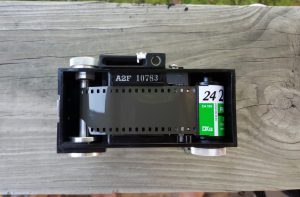
I typically try to maximize lens sharpness on these older models and shoot in well lit conditions, so I would keep the aperture around the middle to smaller sizes anyway, so I figured I’d just leave it alone. I wasn’t prepared to go any further into this shutter considering it’s age and its low value.
When it came time to load film into the camera, I noticed one more issue with the camera relating to the film pressure plate. Unlike every other camera I’ve ever seen where the pressure plate is tensioned by a combination of rivets and springs, the plastic pressure plate on the A2F was held in place by what I assume was rubberized foam. On mine, the foam had disintegrated which caused the pressure plate to come off the rear door. I used a plastic scraper and cleaned off the original foam and used some double sided foam tape to stick the pressure plate back onto the door. If you do this, make sure you pay attention to get the pressure plate where it needs to be so that it covers the film plane correctly.
I didn’t take any pictures of any of my efforts to repair this camera, but if anyone is considering doing this themselves, its all very common sense.
My Results
I don’t want to say I had no expectations of what I might get from this camera, but this is one example where had none of the pictures come out well, I probably wouldn’t have been that disappointed. The mere fact that I’ve put this much into this review however, you’ve probably guessed that wasn’t the case.
Shooting with any scale focus camera is always a tricky thing to do, especially if its one you’ve never used before. I took this camera with me to visit my in-laws in Northern Michigan around fall time so I thought I would try to capture some fall colors. The A2F has an uncoated lens, so I didn’t have high expectations for color, and the sticky aperture meant that I might see some strange dark spots if I used a larger aperture, and how accurate was that shutter anyway?
Using 200 speed film, I kept the shutter at 1/200 for the entire roll and shot with Sunny 16. Knowing that old shutters like this are usually slow, I figured my shots might be slightly overexposed, so whenever I wasn’t sure of which aperture to choose, I erred on the side of smaller, vs larger to compensate for any laggy shutter speeds.
Also knowing that this camera could focus to 15 inches, I had to try it out on something, which you’ll see in a minute, but let me tell you this, focusing on something 15 inches away using a 70+ year old scale focus camera is NOT easy!
Looking through my first roll, I couldn’t help but be impressed. Sure, my expectations were pretty low, but I really like the look of many of these shots. There’s a tad bit of vignetting visible on several of the shots, but nothing that takes away from the look of the picture. The colors are understandably muted, but to be fair, many of these shots were done on an overcast day. It would be interesting to see what this camera can do on some flowers on a bright spring day.
A couple of shots came out soft, but I am sure that is focus-error on my part. The ones shot at infinity came out sharp and clear, so I don’t think there are any issues with the focus on this camera.
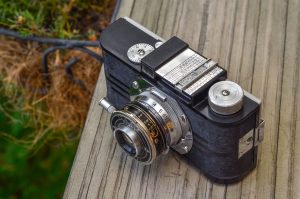
For some reason, a couple of shots came out with a ton of dirt on them. I don’t remember dropping the camera, and it’s only visible on a few shots, so I have no idea what happened there.
And finally, there’s that closeup shot of the Bentley hood ornament. Confession time, I actually took this shot 3 times with the camera at 15 inches for all 3, but me moving my body slightly fore and aft so that I could pick the best shot of the 3. This was a good technique as one of them came out sharper than the other two, but it is a waste of film. I would not recommend an A2F for macro work!
In all, I was very pleased with this camera. It was fun to shoot with, and as it turns out, is a very capable camera. The sticky aperture didn’t appear to negatively impact any of the shots, and the shutter speeds are accurate enough to use Sunny 16 effectively. Before I got these scans back, I wondered if this would be a “one and done” camera, but there’s enough here to interest me for some more rolls. I think I’ll wait until next spring or summer, but as soon as I get more samples, I’ll be sure to update this post.
Related Posts You Might Enjoy
External Links
http://theargusa.com/Models.htm
https://www.throughanoldlens.com/Classic-Cameras/Argus-A2F/
https://simonhawketts.co.uk/2018/04/21/argus-a2f-viewfinder-camera/
http://www.collection-appareils.fr/x/html/page_standard.php?id_appareil=625
http://web.archive.org/web/20190520024340/https://pheugo.com/cameras/index.php?page=argusa

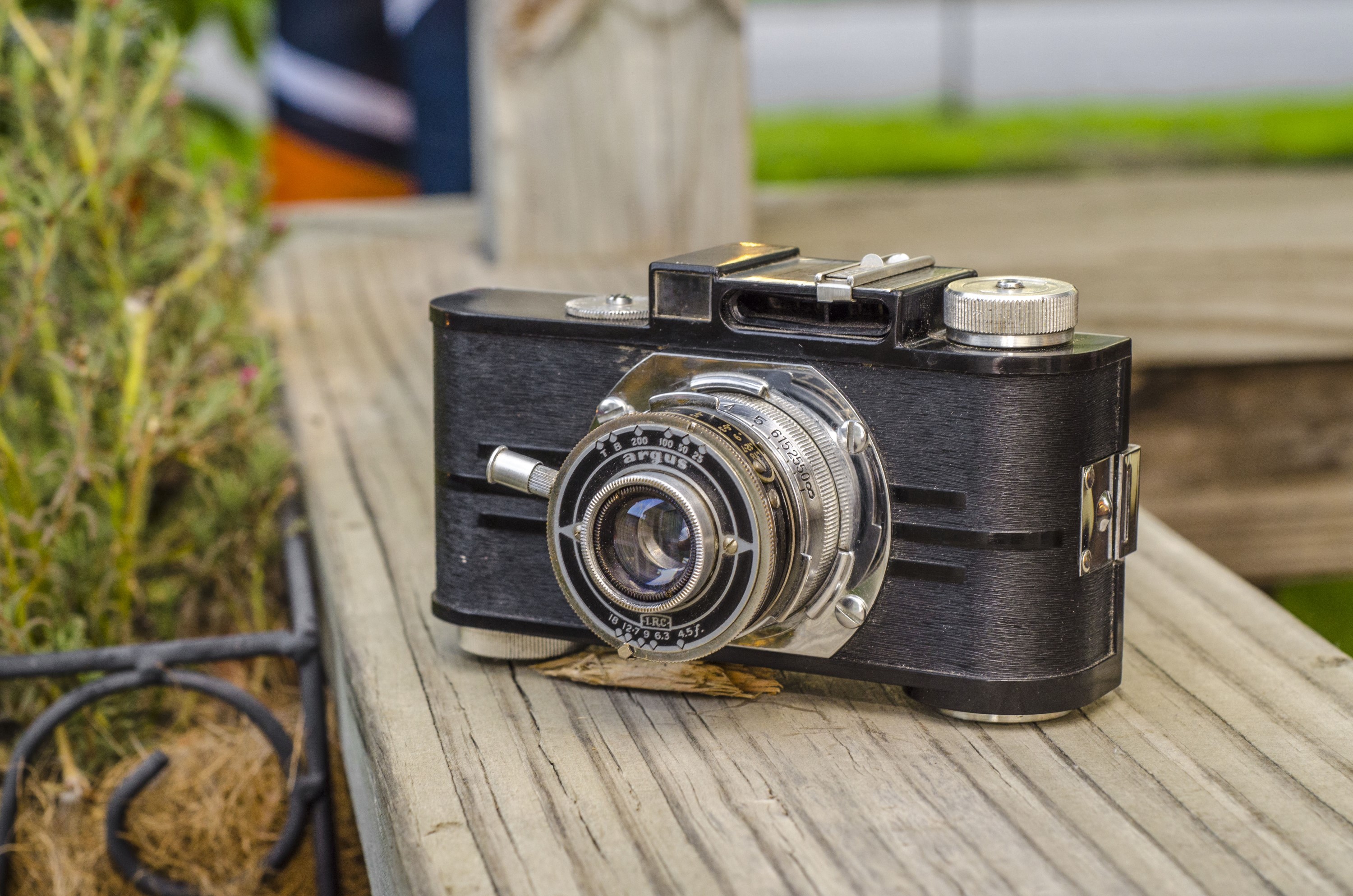
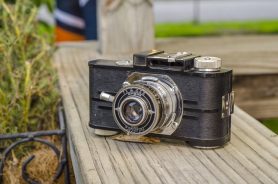
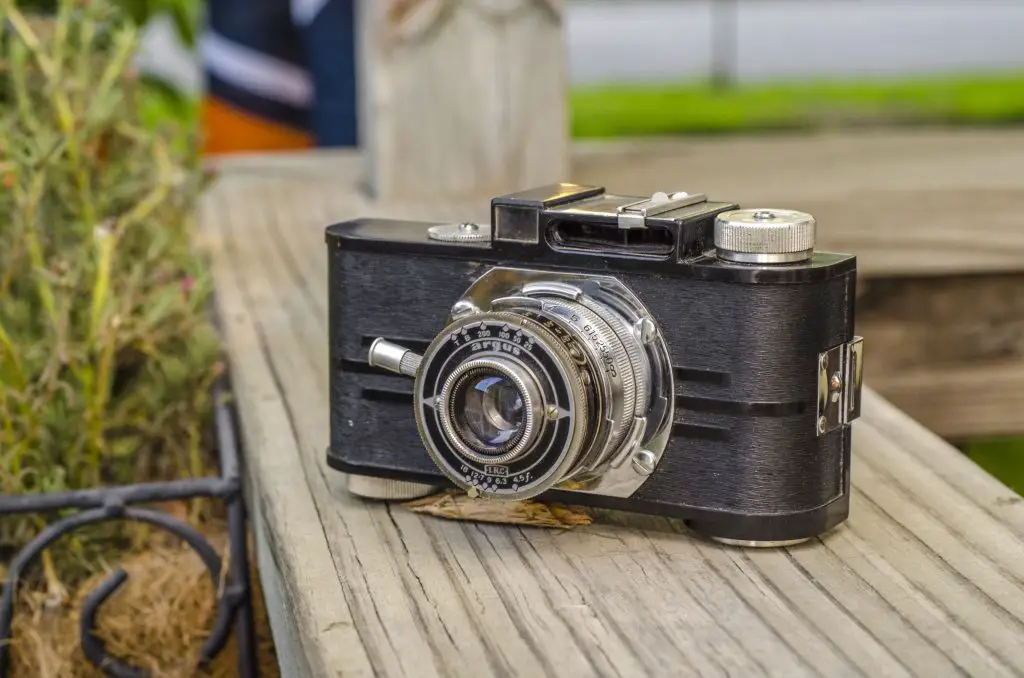








The dirt specks are probably from the light seal where the lens tube enters the body. Argus used a flat velvet ribbon for this and after 75 years they tend to start shedding.
Dan, that makes perfect sense and is probably what happened. Sadly, I have not shot this camera since writing this article, but I’ll be sure to check that the next time I take it out.
The shutter trigger also removes, and you can fit a standard cable release to the shutter if you want to use the camera for long exposures off a tripod.
My daughter got me an A2F as one of my Christmas presents. The camera appears to be in good shape–it just needs to be cleaned a bit. The serial number is 35558, so it probably was made in 1941. It is an interesting little camera.
If you read the manual, the leather tab is to help open the camera back.
Very cool gift from your daughter! Hopefully you’ll get a chance to put some film through it.